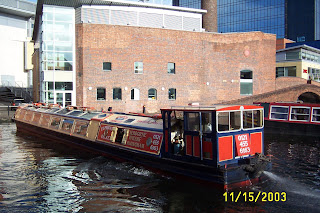As befits our second city, and as it's somewhere I love visiting (especially just before Christmas) I felt it was right to give it its' own page
People slag it off, but they are mostly folk who have never really spent any time there. From the famed BullRing with its colourful markets and shops, to the Chinese quarter, with it's restaurants and chinese shops, there's something for everyone, and everywhere is within easy walking distance, confined by the Expressway.
Birmingham is a magical place at Christmas. Every year, a Weihnachtsmarkt (Christmas market) comes over from Frankfurt in Germany. Local craft stalls are added to the market, which now numbers nearly two hundred stalls.
It stretches from New Street, through the main shopping area outside the railway station, through Victoria Square and Paradise Circus, right into Centenary Square, where it joins a temporary ice skating rink and a Big Wheel.
Add to this, the Christmas lights, and it is a spectacle of colour, music, food and crafts.
Even Brasso, the huge bronze bull at the entrance to the Bullring arcade, puts his Christmas jumper on!

The terrace at the bottom of the Bull Ring, by St. Martin's church, always has a good Christmas display, often aimed at the children, and often with music. Also for the kids, further up in Chamberlain square, you are likely to come across a pen of reindeer. These are the ones who pull Santa in his sleigh up New Street when the Christmas festivities begin, and are then penned in a quiet area, so that everybody can go and see them up close.
At the end of the Christmas market, in Centenary Square, there is usually an outdoor ice rink and a big wheel outside Symphony Hall
This is the brightly lit bar that stands every year at the entrance to the German Markt. There are German crafts and food stalls packed into New Street. At the end of the German market, in Victoria Square, there are bars selling German beers and Gluhwein, and food stalls cooking hot traditional German foods.
But this is not the end of the Christmas Market! From here to Centenary Square the whole thing happens again, but this time with local crafts and food.
However, there is more to Brum than Christmas..........
One of my favourite places in the centre of the city, is Centenary Square. Lying as it does, in the heart of the city, surrounded by such admirable buildings as Symphony Hall, the Birmingham Rep, the International Conference Centre, and the new Central Library, it really is the heart of the West Midlands cultural life.
Above - the War Memorial, below: Symphony Hall
The golden statue, known locally as 'The Carpet Salesmen', it is actually a statue to Matthew Boulton, James Watt and William Murdoch who did much to make Birmingham the central hub that it has become. All roads and railway lines lead to Birmingham (roads to the Gravelly Hill Interchange - or spaghetti junction as it is known, and railway lines to Grand Central station). Birmingham has more miles of canals than Venice.
The striking Selfridge Store, the centrepiece of the new Bull Ring shopping mall
Now - canals. As I said there's more of them than in Venice. The best way to see them, is to take the pubic right of way through the Symphony Hall complex. As you emerge from the rear, there is a bridge over the canal that leads to Brindley Place, a business and catering area. Just below the bridge, is a narrow boat that is known as 'George - the breakfast boat' Lovely breakfasts too!
OK so turn right along the canal walk, and you reach first the Aquarium, and then the junction of 3 canals, complete with a roundabout and 'road' sign.
Turn left along the tow path, and you reach Gas Street Basin, where all the narrow boats moor, and then the Mailbox, once the central sorting office, now a retail and business area, and yet more restaurants.
What else - oh yes, it's our second city, so naturally it has a cathedral. It's called St. Philip's Cathedral. The architecture is not to my taste, but it is rather grand
In 1660 the population of Birmingham was around 6000 people and by 1732 it was estimated to have risen to 15,000. The rapid growth of the town meant the existing parish church of St Martins was no longer adequate to service the population and a new parish church was required.
It was built on higher land given by Elizabeth Phillips. Unusually as a compliment to the family who gave the land. the church was named St Philips.
St Philip's remained a church until 1905 when the new Diocese of Birmingham was created. Rather than fund a new cathedral building Bishop Gore decided to use an existing church as the cathedral and seat of the Bishop.
During the Second World War the windows were removed for safe keeping courtesy of the Civic Society. The foresight was remarkable as the cathedral suffered considerable damage caused by an incendiary bomb dropped in October 1940. However by 1948 the building had been restored and rededicated.

The cathedral is home to a remarkable set of stained-glass windows designed by Birmingham born pre-Raphaelite artist Sir Edward Burne-Jones and manufactured by the firm of William Morris & Co. They were installed over a twelve year period between 1885 and 1897, while St Philip’s was still a parish church. Edward Burne-Jones was born in Birmingham, and baptised in St Philip’s in January 1834.
There is also a museum, which is well worth a visit, if only for the Staffordshire Hoard and the Pre-Raphaelite works of art - and believe me, they're very worth while viewing!
*the museum is currently closed until some point in 2024, as it undergoes a massive refurbishment program. Meanwhile the Staffordshire Hoard is on display at the Potteries Museum.




































No comments:
Post a Comment